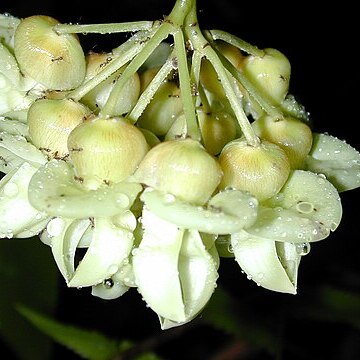Large woody liane attaining 8–15 m. in length.. Stems at first covered with stiff orange-brown hairs, later glabrescent.. Leaflets elliptic or ovate, the laterals oblique, 4·2–11·5 cm. long, 2·2–7·5 cm. wide, acuminate and markedly apiculate at the apex, rounded at the base, glabrous; petiole 4·7–12 cm. long; rhachis 1·8–3·5 cm. long; petiolules 5 mm. long.. Inflorescences mostly from the thick lower stems; rhachis 3–6 cm. long; peduncle 4–22 cm. long; secondary branches 2–7 mm. long, silvery pubescent; pedicels 1–2·5 cm. long; bracts oblong, 7 mm. long, 2·5 mm. wide; bracteoles deciduous, oblong, 1·4 cm. long, 4 mm. wide.. Calyx covered with fine grey pubescence and also long deciduous orange-brown bristles; tube 7–11 mm. long; lobes 2–3 mm. long, the upper lip scarcely emarginate.. Standard pale creamy-green, white or pale lilac, eventually turning black, round, (2–)2·5–3·5 cm. long, (1·6–)2·2–2·6 cm. wide, with very sparse orange bristly hairs, particularly outside at top of claw; wings and keel similarly coloured, (3–)3·7–4·6 cm. long.. Pods stipitate, oblong or oblong-elliptic, 8–15·3 cm. long, 3·5–5(–6·4) cm. wide, 1–1·9 cm. thick, margins with 2 wings, densely covered with stiff intensely irritant orange-brown bristles.. Seeds brown densely mottled with black, discoid, the faces convex, smooth, longest dimension 2·5–2·9 cm., shorter dimension 2·1–2·5 cm., thickness 1·2–1·4 cm.; hilum extending around the seed-margin for ± three-quarters of the circumference.
Large woody liane attaining 8-15 m in length. Stems at first covered with stiff orange-brown hairs, later glabrescent. Leaflets 4.2-11.5 x 2.2-7.5 cm, elliptic or ovate, the laterals oblique, acuminate and markedly apiculate at the apex, rounded at the base, glabrous; petiole 4.7-12 cm long; rhachis 1.8-3.5 cm long; petiolules 5 mm long. Inflorescences mostly from the thick lower stems; rhachis 3-6 cm long; peduncle 4-22 cm long; secondary branches 2-7 mm long, silvery pubescent; pedicels 1-2.5 cm long; bracts 7 x 2.5 mm, oblong; bracteoles 14 x 4 mm, oblong, deciduous. Calyx covered with fine grey pubescence and also long deciduous orange-brown bristles; tube 7-11 mm long; lobes 2-3 mm long, the upper lip scarcely emarginate. Standard pale creamy-green, white or pale lilac, eventually turning black, (2)2.5-3.5 x (1.6)2.2-2.6 cm, round, with very sparse orange bristly hairs, particularly outside at top of claw; wings and keel similarly coloured, (3)3.7-4.6 cm long. Pods stipitate, 8-15.3 x 3.5-5(6.4) x 1-1.9 cm, oblong or oblong-elliptic, margins with 2 wings, densely covered with stiff intensely irritant orange-brown bristles. Seeds brown, densely mottled with black, 2.5-2.9 x 2.1-2.5 x 1.2-1.4 cm, discoid, the faces convex, smooth; hilum extending around the seed-margin for ± three-quarters of the circumference.
A vigorous climbing plant. It keeps growing from year to year. It is woody with coarse rough stems. It looses its leaves during the year. The leaves have 3 leaflets which are smooth and broad and oval. The 2 side leaflets are not equal on either side of their midribs. The leaflet blade is 10-14 cm long by 5-8 cm wide. They are dark green above and paler underneath. The veins are prominent and the tip is pointed. The leaf stalk is 4.5-12 cm long. The flowers are large and green to yellow and like pea flowers. They are 3-5 cm long. They occur in groups of 3 and these are part of larger clusters. The flower stalks are 10-30 cm long and in the axils of leaves on old stems. The flowers hang downwards. The fruit is a broad, flat, woody pod. It is 8-15 cm long by 3-5 cm wide. It is prominently winged along the side. The pod has prickly hairs. There are 2-6 seeds which are round and reddish brown. They are 2-3 cm across.
Standard pale creamy-green, white or pale lilac, eventually turning black, (2)2.5–3.5 × (1.6)2.2–2.6 cm, round, with very sparse orange bristly hairs, particularly outside at top of claw; wings and keel similarly coloured, (3)3.7–4.6 cm long.
Inflorescences mostly from the thick lower stems; rhachis 3–6 cm long; peduncle 4–22 cm long; secondary branches 2–7 mm long, silvery pubescent; pedicels 1–2.5 cm long; bracts 7 × 2.5 mm, oblong; bracteoles 14 × 4 mm, oblong, deciduous.
Leaflets 4.2–11.5 × 2.2–7.5 cm, elliptic or ovate, the laterals oblique, acuminate and markedly apiculate at the apex, rounded at the base, glabrous; petiole 4.7–12 cm long; rhachis 1.8–3.5 cm long; petiolules 5 mm long.
Seeds brown, densely mottled with black, 2.5–2.9 × 2.1–2.5 × 1.2–1.4 cm, discoid, the faces convex, smooth; hilum extending around the seed-margin for ± three-quarters of the circumference.
Pods stipitate, 8–15.3 × 3.5–5(6.4) × 1–1.9 cm, oblong or oblong-elliptic, margins with 2 wings, densely covered with stiff intensely irritant orange-brown bristles.
Calyx covered with fine grey pubescence and also long deciduous orange-brown bristles; tube 7–11 mm long; lobes 2–3 mm long, the upper lip scarcely emarginate.
Stems at first covered with stiff orange-brown hairs, later glabrescent.
Large woody liane attaining 8–15 m in length.

